With the XPS 13 Plus, Dell continues to advance the evolution of the XPS 13 series and takes an extremely minimalist path. The high-quality chassis packs quite a lot of power with Alder Lake-P, but the connections have been reduced to two. A beautiful but energy-hungry display stands in the way of long runtimes.
Table of contents
- 1 A chic notebook for minimalists< ol>
- The XPS evolution at a glance
- Specifications of the Dell XPS 13 Plus (9320)
- Monolithic design at the highest level
- Size and weight remain the same almost the same
- Dell hides the touchpad
- The “Touch Bar” isn't convincing
- The gapless keyboard is nice when writing
- Core i7-1260P from Intel 7 production
- Dell XPS 13 Plus in the benchmark
- What difference does the performance profile make?
- How fast is the iGPU?
- Fast 1 TB SSD from Samsung
- Battery life with a 4K screen
- Compact power supply is undersized
Dell has been offering the traditional XPS 13 in two configurations since this year: XPS 13 Plus and XPS 13. The company presented the XPS 13 Plus in January at the CES as a radical further development of an already puristic series. Just remember the times when an XPS 13 was still equipped with USB-C, USB-A, card reader, headphone jack and dedicated power supply connector, but was still one of the thinnest and lightest notebooks on the market.
An overview of the XPS evolution
These times are over since the 9370 model, which was introduced four and a half years ago, banned USB-A and limited the formerly full-fledged card reader to the microSD format. With the 9380 there was the same layout again, with the 9300 USB-C and the external charge level indicator finally had to give way to the even more compact chassis, which was also used for the 9310 the following year.
XPS 13 Plus relies on Alder Lake-P
The new XPS 13 Plus with the model number 9320 continues the minimalist trend and only offers two ports for Thunderbolt 4. As a result, there is no longer a headphone jack or a microSD card reader. The “plus” in the name does not refer to the size or interfaces, but rather to the processors offered and a plus in equipment compared to the recently introduced XPS 13 (9315), which Dell places on the market as a cheaper variant.
As you can see from the specifications below, Dell only offers the XPS 13 Plus with processors from the Intel Alder Lake-P serieswith the more powerful of the mobile CPUs that take a stand between Alder Lake-U and Alder Lake-H. In the new XPS 13 (9315), on the other hand, only the weaker U processors with a reduced TDP are used. In addition, the XPS 13 Plus is the only variant for which Dell offers an optional OLED screen.
The test device is just under 2,500 euros
The XPS 13 Plus has been available in Germany since the end of April at prices starting at around 1,600 euros. Four or six basic configurations can be found in the manufacturer's online shop, whereby two of them only differ in terms of Windows 11 Pro instead of Home. Further changes can be made for each version in the configurator. The test device with an Intel Core i7-1260P, 32 GB LPDDR5-5200, 1 TB SSD and 4K LCD comes to 2,463.24 euros.
Dell XPS 13 Plus (9320) Specifications
Intel Core i7-1260P (4P + 8E)
Intel Core i7-1280P (6P + 8E) GPU Intel Iris Xe Graphics (96EUs) RAM 8GB LPDDR5-5200
16GB LPDDR5-5200
32GB LPDDR5-5200 SSD 256GB, PCIe 3.0 x4
512GB, PCIe 4.0 x4
1TB, PCIe 4.0 x4
2 TB, PCIe 4.0 x4 display 13.4″, LCD, 1,920 × 1,200, non-touch, matte, 500 cd/m², 2,000:1, 100% sRGB
13.4″, LCD, 1,920 × 1,200, Touch, Glossy, 500 cd/m², 2000:1, 100% sRGB
13.4″, LCD, 3840 × 2400, Touch, Glossy, 500 cd/m², 1650:1, 90% DCI-P3
13.4″, OLED, 3,456 × 2,160, Touch, Glossy, 400 cd/m², 100,000:1, 100% DCI-P3 Connections 2 × Thunderbolt 4 battery 55 Wh Wireless connectivity Wi-Fi 6E, Bluetooth 5.2 Camera 720p webcam , IR camera for Windows Hello Dimensions (W × D × H) 295.3 × 199.04 × 15.28 mm Weight From 1.24 kg Operating system Windows 11, Ubuntu 20.04/22.04 (Developer Edition) Other 4 speakers, fingerprint sensor Price 1,599 euros (i5/8GB/512GB/FHD)
1,899 euros (i7/16GB/1TB/FHD)
2,099 euros (i7/16GB/1TB/FHD)
2,399 Euro (i7/32 GB/1 TB/UHD) Availability since the end of April 2022
Monolithic design at the highest level
From a purely external point of view, the “plus” is initially a “minus”, but not in the negative sense of the ratings, but in relation to the extremely reduced design language. Although it has always been characterized by a monolithic structure, no XPS 13 has so far appeared to be made from one piece like the Plus. The aluminum used for the base, underside and lid not only gives the notebook a high-quality appearance, but also stability, so that even lifting it at the outermost corner does not lead to twisting. You will search in vain for plastic for long stretches, and the rear area of the hinge made of aluminum also merges seamlessly into the lid.
-
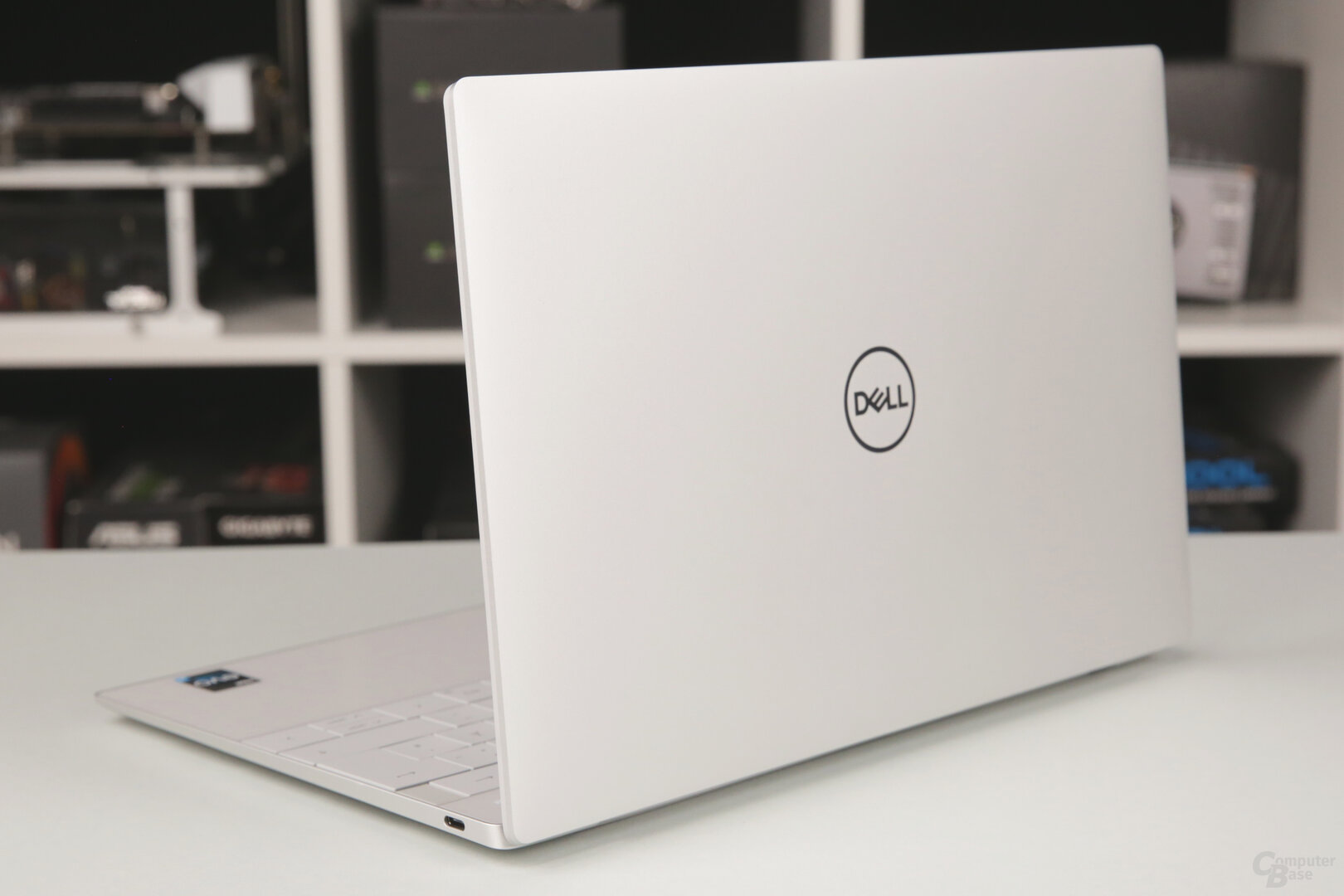 Dell XPS 13 Plus (9320)
Dell XPS 13 Plus (9320)
Image 1 of 5
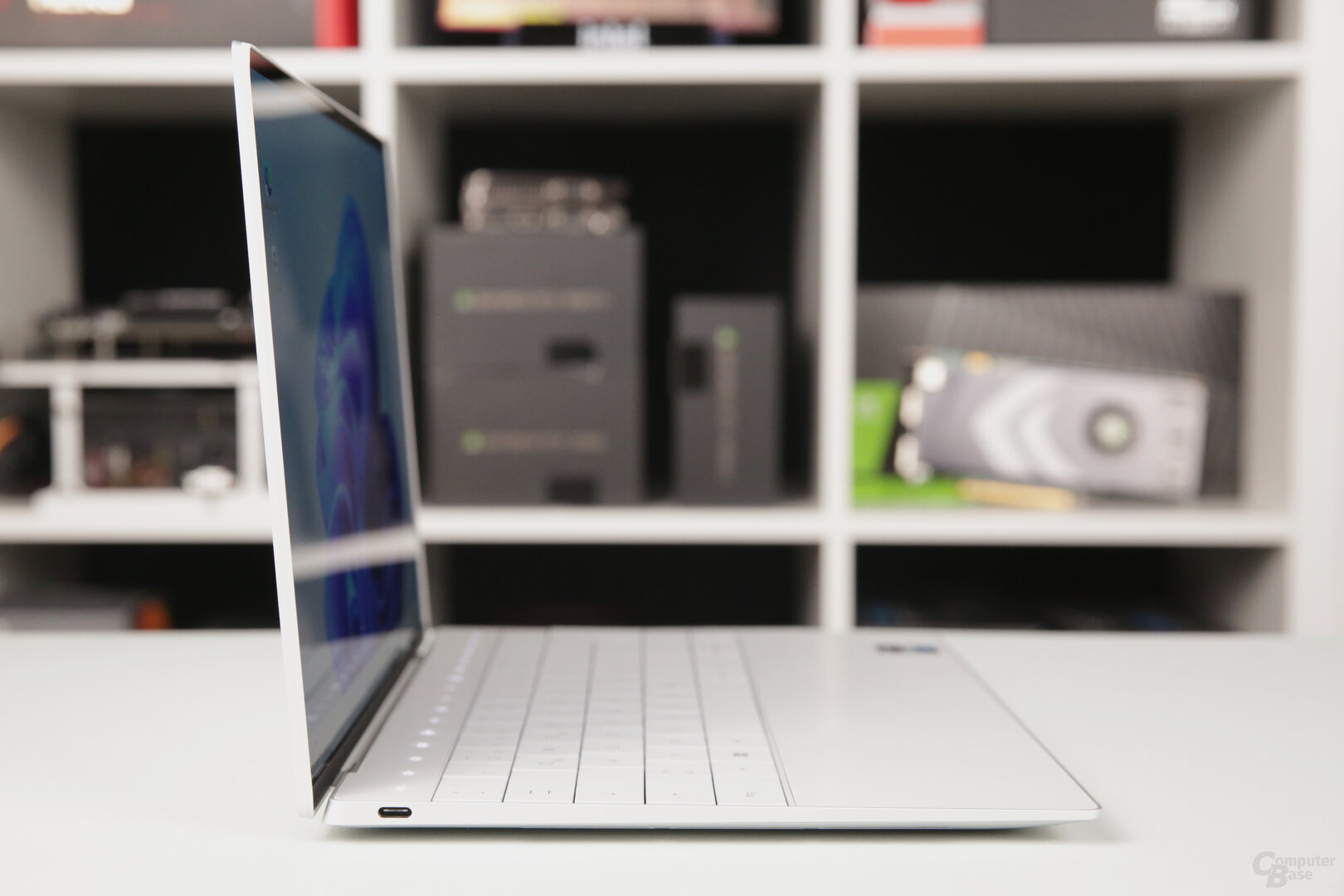 One Thunderbolt 4 each per page
One Thunderbolt 4 each per page The test device comes in the color platinum
The test device comes in the color platinum Side air intake from below
Side air intake from belowPorts reduced to twice Thunderbolt 4
The two Thunderbolt 4 ports, one on the right and one on the left, contribute to the minimalist appearance. Compared to the new MacBook Air, Dell offers customers the option of docking the external monitor, mouse or other accessory on the left or right. However, the disadvantage for the XPS 13 Plus is that one of the ports is inevitably omitted for charging, while Apple uses MagSafe for this and both USB-C ports remain free. In addition, Apple still has a classic headphone jack, despite the AirPods.
The test device in “Platinum” stands on two rubberized strips that protrude in the front and rear areas of the underside almost the entire width of the notebook and ensure a certain stability. The cooling benefits from this only to a limited extent, because the corresponding slots follow later on the side of the convex chassis. The XPS 13 Plus expels hot exhaust air via two fans in the rear area of the hinge.
Height and weight remain almost the same
The notebook measures 295.3 × 199.04 × 15.28 mm (W × D × H) and weighs (from) 1.24 kg. The test device with a 4K LC display, Core i7-1260P, 32 GB RAM and 1 TB SSD weighs exactly 1,249 g. In terms of mass, there have been hardly any changes over the last few years. An old 9360 from 2016, which the editors still follow, weighs almost the same at 1,240 g. At 304 × 200 × 15 mm, the much earlier generation wasn't really larger than the current model either, although Dell was able to fit significantly more ports in it.
Dell hides the touchpad
When opened, the XPS 13 Plus reveals where the big changes are to be found with this generation – or aren't to be found, because you won't find a touchpad, the function keys or speakers, for example. A 29.5 × 8 cm (W × D) large glass element serves as a palm rest, which has very good gliding properties with a fine frosting. In the middle of this element is an invisible “island” measuring about 11.5 × 7.5 cm, on which touch inputs are accepted. The hidden touchpad stretches from the space bar up to and including “Alt Gr” when viewed from the left and almost the entire height of the overlay. There are 2 to 3 mm each in the upper and lower edge area where inputs are no longer recognized. Clicks are performed over the entire area with a corresponding feel and sound.
-
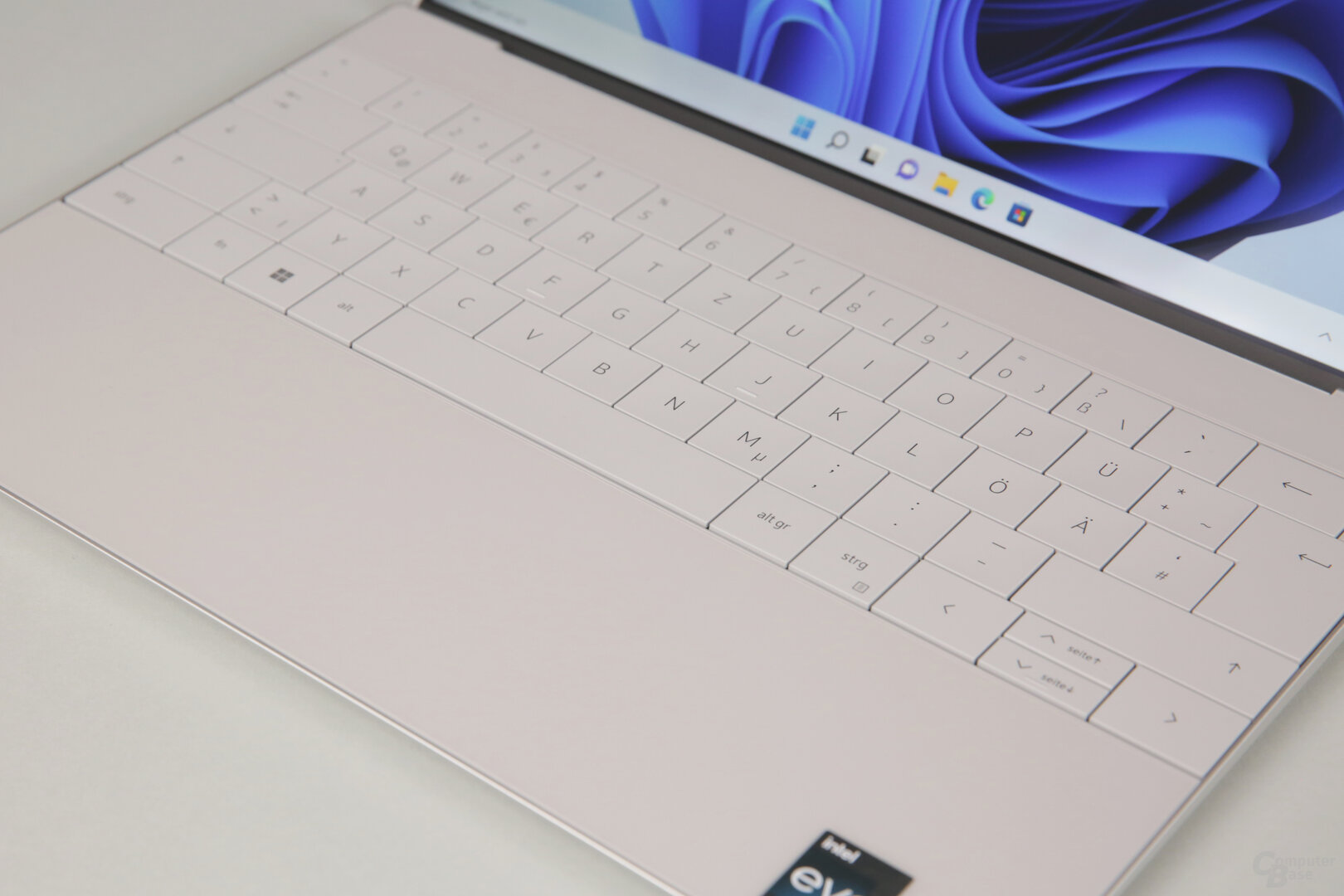 There is no touchpad on the XPS 13 Plus recognizable
There is no touchpad on the XPS 13 Plus recognizable
Image 1 of 2
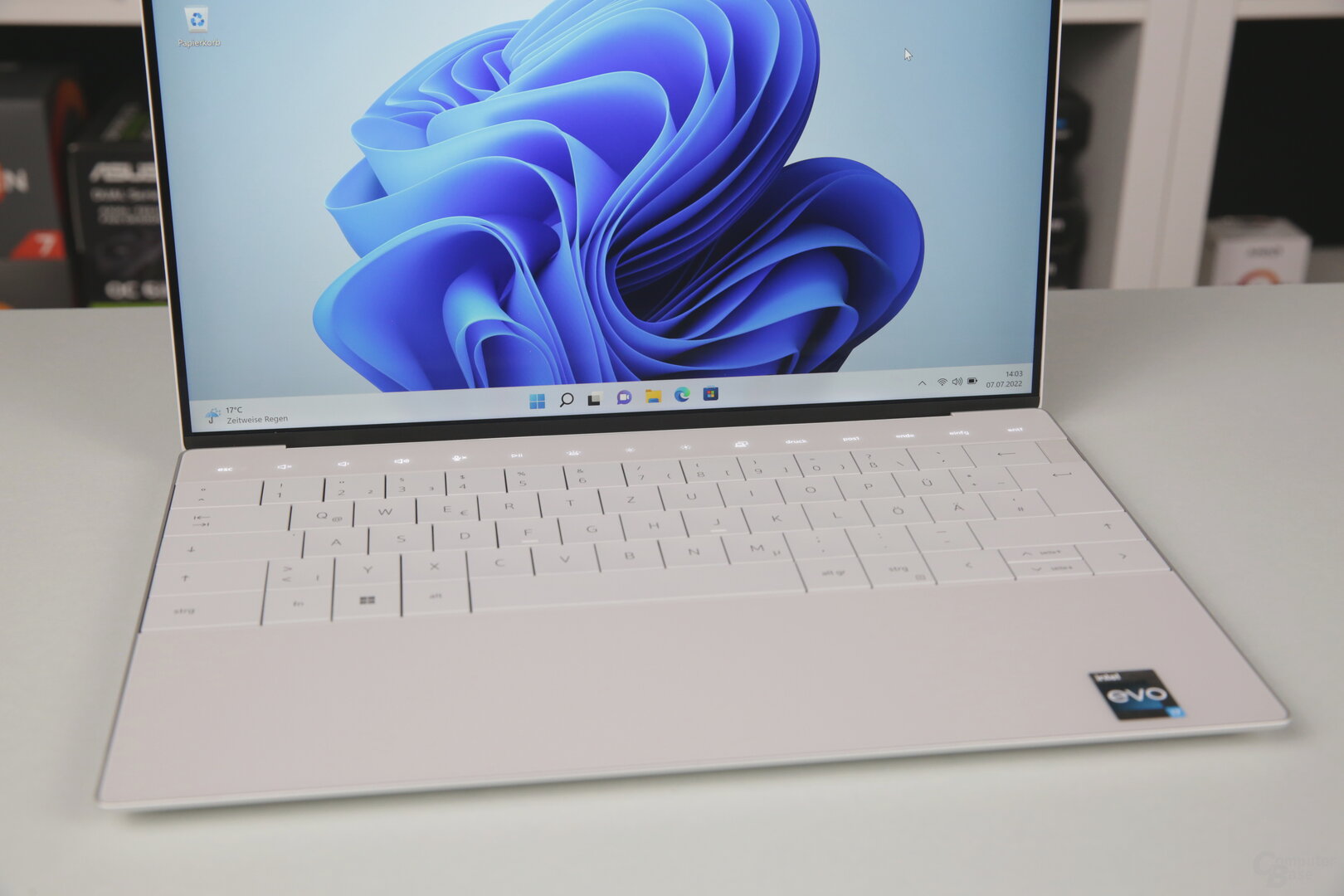 Dell XPS 13 Plus (9320)
Dell XPS 13 Plus (9320)The XPS 13 Plus answers with a clear no whether you have to be able to see where the touchpad is located on a notebook, because during the test it was not a single time that you missed the active zone or didn't find it at all. Since it is a well-known feature of practically all notebooks that the touchpad is located in the center of the palm rest, the operation has become second nature, so that there is no learning curve even with a new device like the XPS 13 Plus. The touchpad is larger overall, there are fewer areas where crumbs and the like can collect, and the notebook also looks smarter.
The “Touch Bar” is not convincing
Dell, on the other hand, gets less praise for the new “Touch Bar”, if you can scold it like that. “Touch Bar” is what Apple was supposed to replace the function keys with a display, turned out to be a hardly used feature and was probably “updated” by Jony Ive before his departure, before Apple realized that pro notebooks needed connections for Pro users.
That Dell is now offering something similar, trying to jump on the “Touch Bar” bandwagon, so to speak, while Apple itself is no longer in the driver's cab is tragically funny. Dell, on the other hand, did not opt for a display, but instead replaced the mechanical function keys with backlit touch keys. In the normal state, the special functions typical of a notebook light up, alternatively “F1” to “F12” appear with the Fn key.
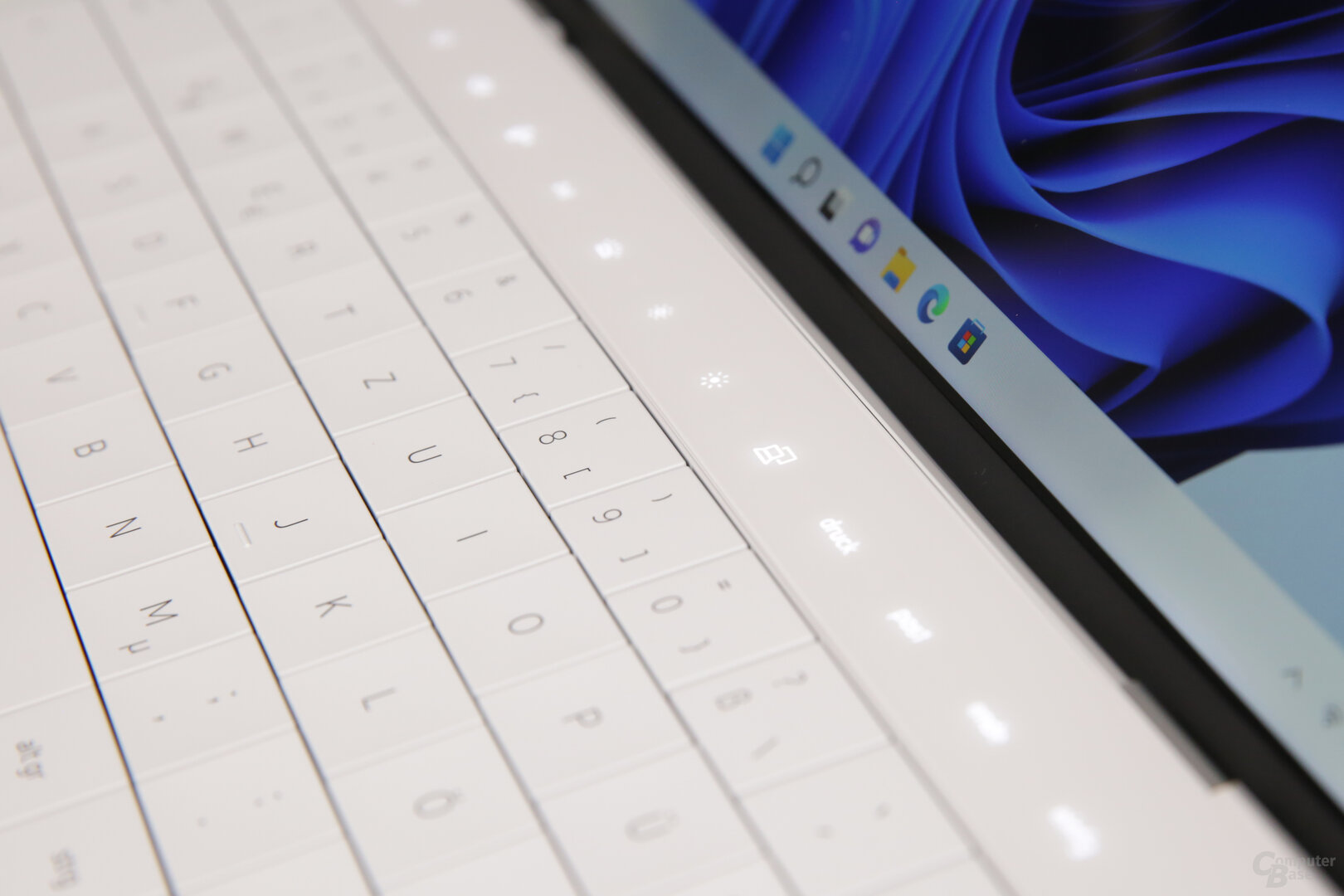 Touch buttons are constantly lit
Touch buttons are constantly litAnd why all this? In addition to the touchpad, Dell probably also wanted to make the area above the keyboard as “clean” as possible. The manufacturer himself says that the smaller design creates more space for other components. The fact that Alder Lake-P finds space in the case and has to be cooled and that the battery is slightly larger than in the 9310 are facts that speak in favor of a solution like the “fake touch bar”.
The lighting remains permanently on
However, Dell's implementation seems half-baked, especially in two respects. On the one hand, there is a constant change of position between the key assignments for the settings and for the function keys. Because, in contrast to Apple, no dynamic display was installed, but Dell only uses LED-illuminated touch keys with a fixed function, the keys cannot be assigned multiple times. This in turn means that when you press the Fn keys, the alternative assignment appears in the previous gap on the right. All the keys are always in the same position on a classic notebook, but on the XPS 13 Plus you always have to move back and forth a few centimeters.
The second point of criticism concerns the backlight, which simply cannot be deactivated or dimmed because it has not been linked to the keyboard backlight, which can be dimmed in two stages or switched off completely. This is still tolerable in office use, but if you watch films on the XPS 13 Plus, a light organ directly in front of the glass-covered and therefore reflective display spoils the fun. The normal buttons turn off after about ten seconds of non-use. Incidentally, only the second, brighter level of the regular keyboard illumination can be used because otherwise the illumination would be uneven.
The keyboard without gaps pleases Write
Dell has done a great job with the keyboard itself, although you have to get used to the new layout at first. The layout is technically the same, except this time Dell has enlarged the keys, removing the previously visible grid between the keys. A key now measures just under 2.1 × 2.1 cm, compared to 1.7 × 1.7 cm on the previous 9360. Dell has also increased key travel by 0.3mm to 1mm.
 The gap-free keyboard
The gap-free keyboardTyping, especially for prolific writers, is quick on the XPS 13 Plus, with sufficient feedback and almost error-free from the Hand. The familiarization phase lies in the fact that you can potentially hit the adjacent key in the edge area of a key because there are no longer any gaps. However, you can counter that by hitting the edge area less often because the keys are larger.
Page 1/4 Next page
Screen and webcam